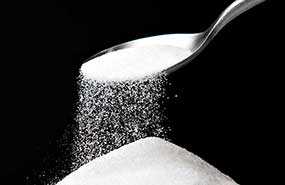Know Your Limit for Added Sugars
Facts about Added Sugars Consumption
 Americans are eating and drinking too much added sugars which can lead to health problems such as weight gain and obesity, type 2 diabetes, and heart disease. To live healthier, longer lives, most need to move more and eat better including getting fewer calories from added sugars. This is one of the Healthy People 2020 objectives1.
Americans are eating and drinking too much added sugars which can lead to health problems such as weight gain and obesity, type 2 diabetes, and heart disease. To live healthier, longer lives, most need to move more and eat better including getting fewer calories from added sugars. This is one of the Healthy People 2020 objectives1.
What are added sugars?
- Added sugars are sugars and syrups that are added to foods or beverages when they are processed or prepared. Naturally occurring sugars such as those in fruit or milk are not added sugars.
- Added sugars are called by many different names. Examples of added sugars seen on ingredient labels, according to the 2015-2020 Dietary Guidelines for Americans,2 include brown sugar, corn sweetener, corn syrup, dextrose, fructose, glucose, high-fructose corn syrup, honey, lactose, malt syrup, maltose, molasses, raw sugar, and sucrose.
Americans should limit their added sugars consumption
- Americans should keep their intake of added sugars to less than 10% of their total daily calories as part of a healthy diet.2 For example, in a 2,000 daily calorie diet no more than 200 calories should come from added sugars.
- Americans, aged 6 years and older, consumed about 14% of total daily calories from added sugars in 2003–2010.3
- The leading sources of added sugars in the U.S. diet are sugar-sweetened beverages, grain-based desserts like cakes and cookies, candy, and dairy desserts like ice cream.3 Reducing the amount of sugary drinks and sugary foods each day and replacing these with plain water and fruit might be a good way to reduce added sugars intake.
 Added sugars consumption varies by age, sex, race, and ethnicity.
Added sugars consumption varies by age, sex, race, and ethnicity.
- In 2005–2010, the average percent of total daily calories from added sugars was 13% (average intake of 335 calories) for men and 13% (average intake of 239 calories) for women aged 20 and over.4
- In 2005–2008, the average percent of total daily calories from added sugars was 16% (average intake of 362 calories) for boys and 16% (average intake of 282 calories) for girls aged 2 to 19 years. 5
- Non-Hispanic white youth consume more added sugars than do Mexican-American youth,5 and non-Hispanic black adults consume more added sugars than non-Hispanic white and Mexican-American adults.4
Added sugars consumption varies by socioeconomic status and behavioral characteristics.
- There is no difference in added sugars intake by income among youth;5 however, added sugars intake is higher among lower-income adults.4
- Added sugars intake is higher among adults who are younger, less educated, are less physically active, are current smokers, and are former or current infrequent or light drinkers.6
Resources
References
- US Department of Health and Human Services. Healthy People Objective 2020.
- U.S. Department of Agriculture, U.S. Department of Health and Human Services. Dietary Guidelines for Americans, 2015-2020. 8th Edition ed. Washington, DC: U.S. Government Printing Office; . Accessed March 8, 2016.
- Drewnowski A, Rehm CD. Consumption of added sugars among US children and adults by food purchase location and food source. Am J Clin Nutr. 2014;100(3):901-907.
- Ervin RB, Ogden CL. Consumption of added sugars among U.S. adults, 2005-2010. NCHS Data Brief. 2013(122):1-8.
- Ervin RB, Kit BK, Carroll MD, Ogden CL. Consumption of added sugar among U.S. children and adolescents, 2005–2008. NCHS Data Brief. 2012;No.87:1-8.
- Park S, Thompson F, Pan L, McGuire LC, Galuska D, Blanck HM. Sociodemographic and behavioral factors associated with added sugars intake among US adults. J Acad Nutr Diet. 2016;116(10):1589-1598.
- Page last reviewed: September 9, 2016
- Page last updated: September 27, 2016
- Content source:


 ShareCompartir
ShareCompartir